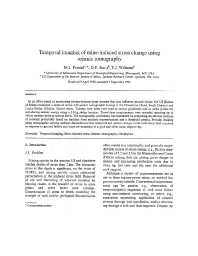Mining Publication: Temporal Imaging of Mine-Induced Stress Change Using Seismic Tomography
Original creation date: January 1997
In an effort aimed at monitoring mining-induced stress changes that may influence ground failure, the U.S. Bureau of Mines conducted a series of active 3-D seismic tomographic surveys at the Homestake (Lead, South Dakota) and Lucky Friday (Mullan, Idaho) mines. Existing rock bolts were used to mount geophones and as strike points for introducing seismic energy using a 3.6 kg sledge hammer. Travel time measurements were recorded spanning up to 160 m between drifts at several levels. The tomographic uncertainty was minimized by computing iso-velocity surfaces of constant probability based on statistics from multiple reconstructions and a threshold criteria. Periodic imaging using tomographic velocity surfaces demonstrated that temporal and spatial changes in the local stress field occurred in response to ground failure and stope advancement at a told and silver mine, respectively.
Authors: MJ Friedel, DF Scott, TJ Williams
Peer Reviewed Journal Article - January 1997
NIOSHTIC2 Number: 20025394
Eng Geol 1997 Jan 46(2):131-141
See Also
- Advance and Relieve Mining: A Method to Mitigate the Effects of High Horizontal Stress on the Mine Roof
- Detecting Strata Fracturing and Roof Failures from a Borehole Based Microseismic System
- Horizontal Stress and Longwall Headgate Ground Control
- Local Earthquake Tomography for Imaging Mining-Induced Changes Within the Overburden above a Longwall Mine
- The Relationship of Roof Movement and Strata-Induced Microseismic Emissions to Roof Falls
- Safer Mine Layouts for Underground Stone Mines Subjected to Excessive Levels of Horizontal Stress
- Seismic Detection of Trapped Miners Using In-Mine Geophones
- Three-Dimensional Time-Lapse Velocity Tomography of an Underground Longwall Panel
- Time-Lapse Tomography of a Longwall Panel: A Comparison of Location Schemes
- Variation of Horizontal Stresses and Strains in Mines in Bedded Deposits in the Eastern and Midwestern United States
- Content source: National Institute for Occupational Safety and Health, Mining Program


 ShareCompartir
ShareCompartir
